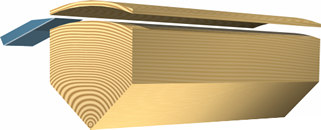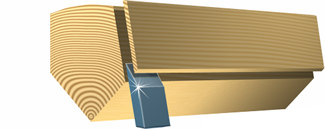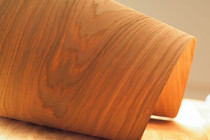Veneer cutting methods
Veneer cutting methods
Wood
Different types of wood have its own characteristics. Grains, colors and nodes are varied even among a spice of a wood. The beauty of wood is depending on color, texture and shape of the grains which is the main reason of selecting natural wood and supplies by the wood lovers. This is the magic of wood.
Wood’s veneer patterns are different from the cutting points; some of them are briefly referred here including two kinds of cutting procedure.



Spiral or stripe pattern
Radial pattern
Flat or curved pattern
Radial pattern
Wavy pattern
Blister pattern
Bird pattern
Layered pattern
Bean eyed pattern
Two-branch pattern
Loop pattern
Pigment pattern
moonlight pattern

Rotary - cut veneer
Rotary peeling using a lathe accounts for nearly 95% of all veneer production. It involves centering the log or bolt onto the lathe chuck. The log is slowly rotated and the knife carriage moved into the log. The knife then converts the bolt into a cylinder. In this process of rounding, various widths and lengths of wood (fishtails) are removed from the log surface.
Sliced face veneers from a given flitch are stacked and bundled in the exact consecutive order in which they are cut from the bolt. Special care is then taken to maintain this sequence of individual veneers during all subsequent operations, so that veneer matching can be more easily attained. This bundle of sliced veneers is also called a flitch.
The gears feed the blade towards the bolt as its diameter is reduced, so that veneer is unwinding in a continuous ribbon.
Veneer recovery from bolts is variable ranging depending on bolt size and process variables. With the increase of technology the recovery rate percentage is increasing.
Since this cut follows the log's annual growth rings, a wide, bold grain pattern is produced. Rotary cut veneer is a cost effective method to obtain remarkable effects from birch, maple and oak.
Veneers producing by this cut are cheaper than other coatings but most suitable for the back of job and in some cases have tendency to stain coating are suitable. This type of coating due to the low price and lack of appropriate design are producing from inexpensive trees.
Sectional Cut Veneer
Unlike the above mentioned production’s process the system of sectional sliced is quite different. A lumber is passed flat over a stationary knife. As it passes, a sheet of veneer is sliced from the lengthwise of the board by a blade with a 90 degrees angle and forth and back movement. This process is primarily due to the lack of smooth sections of the trunk and branches have too wastes.
At every stage of the section sliced the width of the veneer start with narrow from the beginning and increase in the middle and again decrease in the end.
This type of veneer has a higher price than the first type of approach. This is not only due to the wastages but for the designs and plans of the sliced section surface which unique each veneer’s design.

Engineered Veneers
Engineered veneer is a kind of recomposed decorative material. This new decorative material with better quality than that of nature rare wood materials, is produced from normal wood or fast-growing wood, according to the theory of bionics and computer stimulation design, by cutting the wood into single board with a thickness of 0.1mm-0.4mm and using special processes of whitening and dyeing.
The engineered veneer uses natural properties of heat insulation, isolation, temperature adjustment and humidity. According to clients’ needs, engineered veneer can be made with the texture and color of various natural rare woods. Brighter and more colorful colors and stronger three-dimensional sense realize your dreams. The physical properties of density and static bending strength of engineered veneer is better than natural veneer, in addition, the properties of fire-proofing and antisepsis are better.
The engineered veneer is applicable for modern new decoration and traditional classic decoration. Various types and colors meet the increasing individual consumption needs of people. The engineered veneer saves your material cost on residential decoration and prevents you from troubles of difficult and impossible connection resulted from texture and color of natural wood. You can make good use of each raw material that you have bought.
Comments
Telka , One of the largest manufacturers of wood
The shop all goods and services, are required to have the necessary permits from the relevant authorities and the activities of this site are subject to the laws and regulations of the Islamic Republic of Iran.

